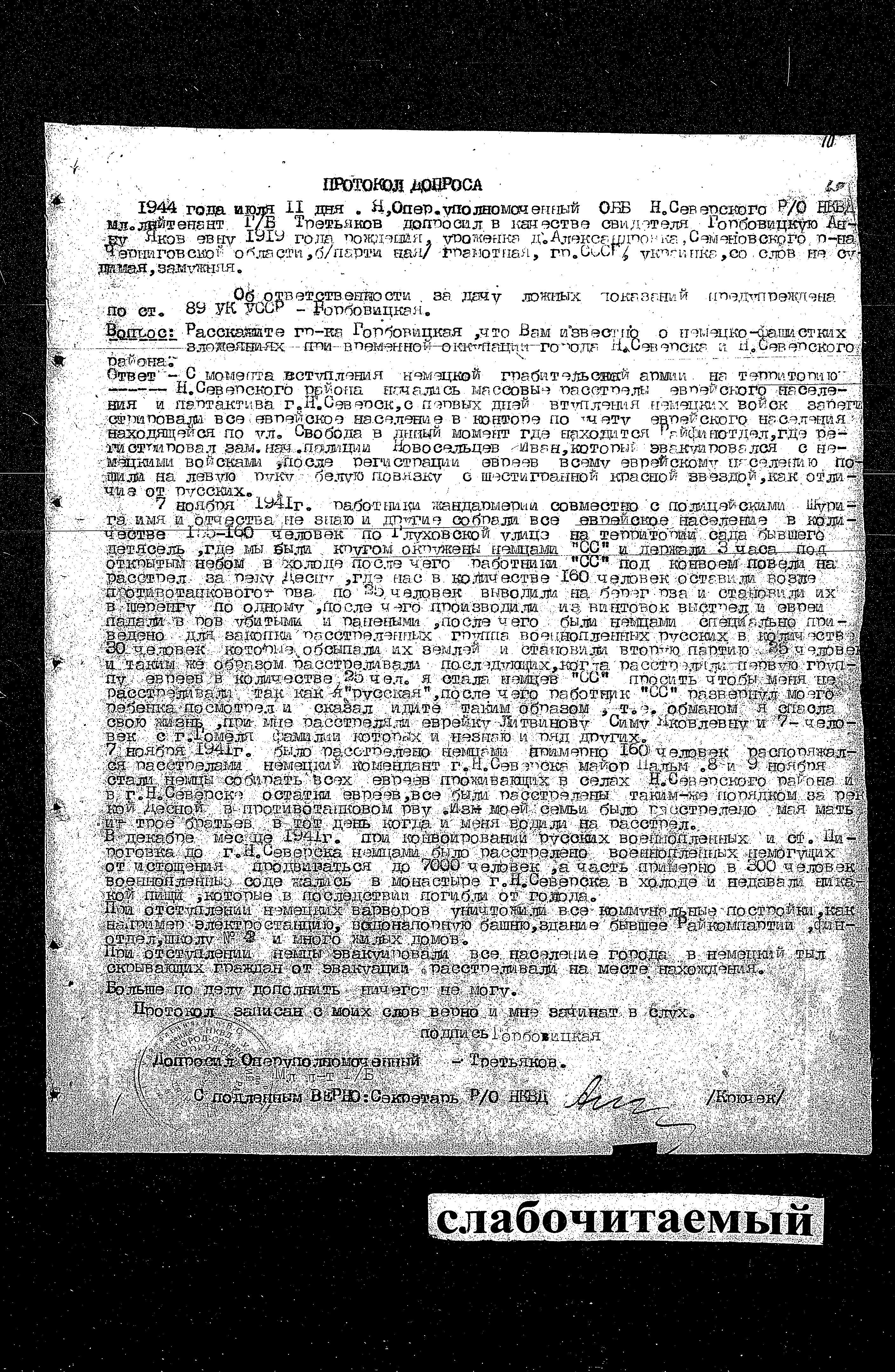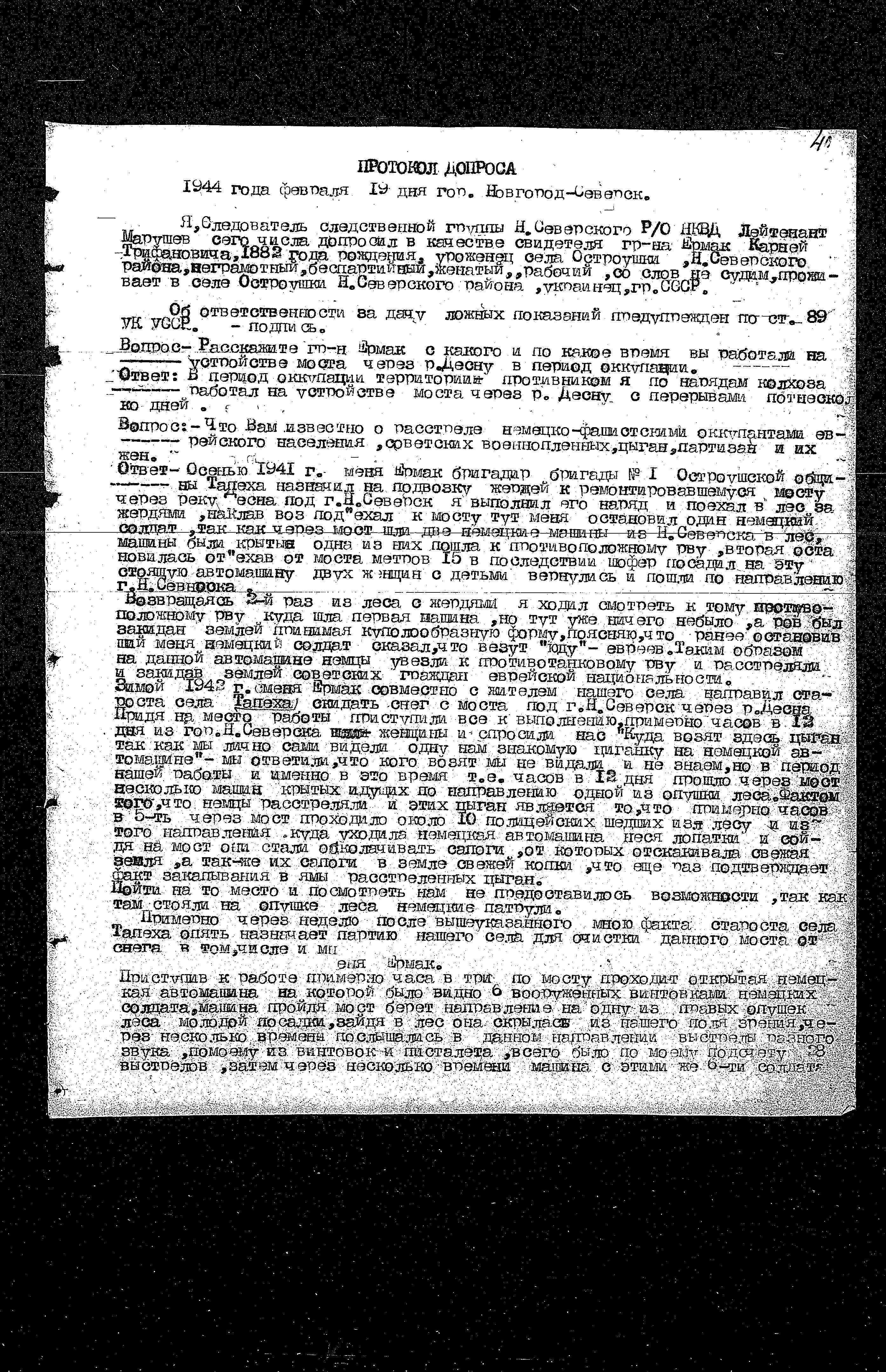Ostroushki Related Communities
# Follow us
Languages
English
עברית
Русский
español
Deutsch
Français
ABOUT THE HOLOCAUST
RESEARCH & COLLECTIONS
COMMEMORATION
EDUCATION & E-LEARNING
MUSEUMS & EXHIBITIONS
RIGHTEOUS

Murder Story of Novgorod Severskiy Jews in Ostroushki
Murder Site
Ostroushki
Ukraine (USSR)
On November 7, 1941, the anniversary of the October Revolution, about 155 Jews who remained in the village were shot by the 555th detachment of the 10th Infantry Regiment of the 1st SS Mechanized Infantry Brigade with the assistance of Ukrainian police. The Jews were ordered to appear with their belongings at a meeting point near a kindergarten in Novgorod Severskiy for the ostensible purpose of resettlement. They were surrounded by Ukrainian policemen and taken to the other side of the Desna River. The river was frozen and the group crossed over on the ice. The Jews were taken to anti-tank trenches located close to the river near the village of Ostroushki, and shot there by Germans with the help of Ukrainian police.
The rest of the local Jews, those who did not carry out the order to assemble, were rounded up from their homes on November 8-9, 1941 and shot at the same murder site by Germans with the help of Ukrainian policemen. Some Jews from Novgorod Severskiy County and at least 7 Jews from Gomel were shot at this mass murder site. A total of 174 Jews were shot on November 7-9, 1941. On German orders the bodies were buried in the trenches by Soviet prisoners of war.
Related Resources
ChGK Soviet Reports
Anna Gorbovitskaya, who was born in 1919 and lived in Novgorod Severskiy during the war years, testified:
… On November 7, 1941 members of the gendarmerie, together with the policeman Shuriga – I do not remember his first name or patronymic – and others collected all the Jewish population, numbering about 150-160, in a garden of a former kindergarten, where we were surrounded by Germans from the SS and were held outside for three hours in the cold. Afterwards members of the SS took us across the Desna River, where we 160 people were taken close to an anti-tank trench. We were taken in groups of 25 people to the edge of the trench, lined up in close rows, and then shot with rifles. The Jews fell into the trench, some were killed, some were [only] wounded. The Germans brought a group of 30 Russian prisoners, who covered them [the murdered Jews] with earth. Then a second group of 25 people was lined up and shot in the same way. After the first group was shot, I asked Germans from the SS not to shoot me because I was Russian. A member of the SS unwrapped my child, looked at it, and told me to leave. That way, by deceit, I saved my life. In front of my eyes the Jew Sima Yakovlevna Litvinova and 7 other Gomel Jews whose names I do not know, were shot along with many others.
On November 7, 1941 about 160 Jews were shot by Germans on the order of the German commander of the town of Novgorod Severskiy, Mayor Palm. On November 8 and 9 [1941] Jews from villages in Novgorod Severskiy County and the remaining Jews from the town of Novgorod Severskiy were collected and shot in the same way, across the Desna River, in anti-tank trenches…
GARF, MOSCOW R-7021-78-22 copy YVA M.33 / JM/19994
ChGK Soviet Reports from Novgorod Severskiy
… Grave number 3 is located in the same ravine, 200 meters south of the second grave. At a depth of 3/4 meter bodies were discovered strewed in a haphazard manner. The size of the grave is 10 x 4x 2 meters. The bodies were lying in several rows. These are the bodies of Jews who were murdered, according to eyewitnesses, on September 7, 1941. Among them there were old people, women, and children, a total of 174 bodies. Most of the bodies were clothed in fall-winter garments. There were no documents or other objects in their pockets. It is impossible to determine the cause of death because the flesh and parts of the skeletons are in an advanced state of decay….
GARF, MOSCOW R-7021-78-22 copy YVA M.33 / JM/19994
Feofaniya Nosach, who was born in 1931, testified:
… I know that shootings of the Jewish population and of Communist activists started from the beginning of the occupation of Novgorod Severskiy by the German bandit army. From the first days after the Germans entered Novgorod Severskiy the Jews were registered at the office of the city mayor, which was established by Germans and where Korolyov – I do not remember his first name or his patronymic – was the mayor. An armband with a red star was [required to be] worn by Jews on their sleeves. On November 7, 1941 all the registered Jews, numbering about 160, were collected near the pioneer club on Gluchovskaya Street, where they were kept outside in the rain and cold for about 4 hours. Thereafter, a 30-member SS unit, whose commander’s name is not known started to beat them with rifle butts and push old people with rods, while calling the old [Jewish] women "Judases." At about 12 noon a group of 160 Jews, including me and my two-year old child, were taken to be shot across the Desna River, where there were some anti-tank trenches. When we reached the trenches, the Germans forced all of the Jews into the trenches. I asked the Germans not to shoot me. I said to them that I was not Jewish but Ukrainian. They glanced at me and told me to run away from that place fast. When I left and had reached the bridge, I heard shooting and the screaming and groaning of men, women, and children. The group of 160 Jews was then brutally shot. When I was with the Jews, I saw a group of prisoners of war who were brought by the Germans to bury the group of Jews who had been shot. They [the POWs] stood with shovels in their hands and were afraid of looking at anyone. While the SS squad was guarding these Jews, helpless old men and women and children, who had been were left behind by the main group, were randomly loaded onto carts and taken to the shooting place. On German orders some of those who could not walk were carried by other Jews who were their close relatives.
On the second and third days after the shooting of the first group a German group, together with policemen, including deputy chief of police Novoseltsev – I do not remember his first name or patronymic, and the policemen Rayevsky, who were evacuated with the Germans, started to round up from their apartments Jews who had not turned up to be shot with the first group. The second time, about 50 people [Jews] were found: like the first time, they were shot with the participation of policemen – whose names I do not know – across the Desna at the anti-tank trenches….
GARF, MOSCOW R-7021-78-22 copy YVA M.33 / JM/19994
Karney Yermak, who was born in 1882, testified:
… In the autumn of 1941, I, Yermak, was ordered by Tapekha - the brigade leader of the 1st [work] brigade from the village of Ostroushko – to bring some wood to the Desna River bridge, which needed to be repaired, near Novgorod Severskiy. I followed his orders and went to the forest to get the wood. After loading the cart, I went to the bridge, where I was stopped by a German soldier because two trucks were crossing the bridge from Novgorod Severskiy to the forest. The trucks were covered. The first truck drove up to a trench; the second stopped 15 meters away from the bridge. The driver [of the second truck] loaded two women with children onto the truck, turned around, and headed toward Novgorod Severskiy. When I returned for the second time from the forest with wood, I went to take a look at that anti-tank trench where the first truck had been, but there wasn’t anything in that place any longer. The trench was covered with earth, which gave it the shape of a dome. I have to mention that the German soldier who stopped me earlier had told me that they were transporting "Jude" – Jews. That means that in that truck the Germans were driving Soviet civilians of Jewish nationality to the anti-tank trench, shooting them, and covering them with earth….
GARF, MOSCOW R-7021-78-22 copy YVA M.33 / JM/19994
Ostroushki
Murder Site
Ukraine (USSR)
52.063;33.354
Videos
Liudmila Porokhova was born in 1939 in Novgorod Severskiy and lived there during the war years
USC SHOAH FOUNDATION, 49228 copy YVA O.93 / 49228




